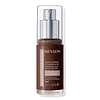What's inside
What's inside
 Key Ingredients
Key Ingredients

 Benefits
Benefits

 Concerns
Concerns

 Ingredients Side-by-side
Ingredients Side-by-side

Water
Skin ConditioningCyclopentasiloxane
EmollientPhenyl Trimethicone
Skin ConditioningSqualane
EmollientPEG-10 Dimethicone
Skin ConditioningNeopentyl Glycol Diheptanoate
EmollientPropanediol
SolventPPG-24-Glycereth-24
EmulsifyingTrimethylsiloxysilicate
EmollientDimethicone
EmollientGlycerin
HumectantLecithin
EmollientMagnesium Sulfate
1,2-Hexanediol
Skin ConditioningAmmonium Acryloyldimethyltaurate/Vp Copolymer
C11-15 Alketh-40
CleansingC11-15 Pareth-7
EmulsifyingCamellia Sinensis Leaf Extract
AntimicrobialCaprylic/Capric Triglyceride
MaskingCaprylyl Glycol
EmollientDisteardimonium Hectorite
StabilisingEthylene/Acrylic Acid Copolymer
Emulsion StabilisingGlycyrrhiza Glabra Root Extract
BleachingHaematococcus Pluvialis Extract
AntioxidantLithospermum Erythrorhizon Root Extract
Skin ConditioningPEG/PPG-18/18 Dimethicone
EmulsifyingPolysilicone-11
Simethicone
EmollientSodium Hyaluronate
HumectantSodium Laureth-12 Sulfate
CleansingStyrene/Acrylates Copolymer
Tetrasodium EDTA
Tocopheryl Acetate
AntioxidantTriethoxycaprylylsilane
Triethyl Citrate
MaskingPhenoxyethanol
PreservativeCI 77163
Cosmetic ColorantCI 77491
Cosmetic ColorantCI 77492
Cosmetic ColorantCI 77499
Cosmetic ColorantCI 77891
Cosmetic ColorantWater, Cyclopentasiloxane, Phenyl Trimethicone, Squalane, PEG-10 Dimethicone, Neopentyl Glycol Diheptanoate, Propanediol, PPG-24-Glycereth-24, Trimethylsiloxysilicate, Dimethicone, Glycerin, Lecithin, Magnesium Sulfate, 1,2-Hexanediol, Ammonium Acryloyldimethyltaurate/Vp Copolymer, C11-15 Alketh-40, C11-15 Pareth-7, Camellia Sinensis Leaf Extract, Caprylic/Capric Triglyceride, Caprylyl Glycol, Disteardimonium Hectorite, Ethylene/Acrylic Acid Copolymer, Glycyrrhiza Glabra Root Extract, Haematococcus Pluvialis Extract, Lithospermum Erythrorhizon Root Extract, PEG/PPG-18/18 Dimethicone, Polysilicone-11, Simethicone, Sodium Hyaluronate, Sodium Laureth-12 Sulfate, Styrene/Acrylates Copolymer, Tetrasodium EDTA, Tocopheryl Acetate, Triethoxycaprylylsilane, Triethyl Citrate, Phenoxyethanol, CI 77163, CI 77491, CI 77492, CI 77499, CI 77891
Water
Skin ConditioningDicaprylyl Carbonate
EmollientDicaprylyl Ether
EmollientGlycerin
HumectantTrimethylsiloxysilicate
EmollientAluminum Starch Octenylsuccinate
AbsorbentEthylhexyl Methoxycinnamate
UV AbsorberSodium Chloride
MaskingZinc Oxide
Cosmetic ColorantTri (Polyglyceryl-3/Lauryl) Hydrogenated Trilinoleate
EmulsifyingStearalkonium Bentonite
Gel FormingSilica
AbrasiveCetyl PEG/PPG-10/1 Dimethicone
EmulsifyingMica
Cosmetic ColorantPropylene Carbonate
SolventTocopherol
AntioxidantPanthenol
Skin ConditioningSodium Benzoate
MaskingTriethoxycaprylylsilane
Chlorphenesin
AntimicrobialAloe Barbadensis Leaf Juice
Skin ConditioningMethicone
EmollientPantolactone
HumectantBHT
AntioxidantPentaerythrityl Tetra-Di-T-Butyl Hydroxyhydrocinnamate
AntioxidantCI 77891
Cosmetic ColorantIron Oxides
Water, Dicaprylyl Carbonate, Dicaprylyl Ether, Glycerin, Trimethylsiloxysilicate, Aluminum Starch Octenylsuccinate, Ethylhexyl Methoxycinnamate, Sodium Chloride, Zinc Oxide, Tri (Polyglyceryl-3/Lauryl) Hydrogenated Trilinoleate, Stearalkonium Bentonite, Silica, Cetyl PEG/PPG-10/1 Dimethicone, Mica, Propylene Carbonate, Tocopherol, Panthenol, Sodium Benzoate, Triethoxycaprylylsilane, Chlorphenesin, Aloe Barbadensis Leaf Juice, Methicone, Pantolactone, BHT, Pentaerythrityl Tetra-Di-T-Butyl Hydroxyhydrocinnamate, CI 77891, Iron Oxides
 Reviews
Reviews

Ingredients Explained
These ingredients are found in both products.
Ingredients higher up in an ingredient list are typically present in a larger amount.
Ci 77891 is a white pigment from Titanium dioxide. It is naturally found in minerals such as rutile and ilmenite.
It's main function is to add a white color to cosmetics. It can also be mixed with other colors to create different shades.
Ci 77891 is commonly found in sunscreens due to its ability to block UV rays.
Learn more about CI 77891Glycerin is already naturally found in your skin. It helps moisturize and protect your skin.
A study from 2016 found glycerin to be more effective as a humectant than AHAs and hyaluronic acid.
As a humectant, it helps the skin stay hydrated by pulling moisture to your skin. The low molecular weight of glycerin allows it to pull moisture into the deeper layers of your skin.
Hydrated skin improves your skin barrier; Your skin barrier helps protect against irritants and bacteria.
Glycerin has also been found to have antimicrobial and antiviral properties. Due to these properties, glycerin is often used in wound and burn treatments.
In cosmetics, glycerin is usually derived from plants such as soybean or palm. However, it can also be sourced from animals, such as tallow or animal fat.
This ingredient is organic, colorless, odorless, and non-toxic.
Glycerin is the name for this ingredient in American English. British English uses Glycerol/Glycerine.
Learn more about GlycerinTriethoxycaprylylsilane is a silicone used to bind and stabilize ingredients.
As an emulsifier, it helps prevent ingredients from separating. This can help elongate the shelf life of products.
Triethoxycaprylylsilane is often used to coat mineral sunscreens ingredients to help give a better feel. It also helps reduce oxidative stress in sunscreens.
Learn more about TriethoxycaprylylsilaneThis silicone is an emollient. Emollients create a thin film on the skin to prevent moisture from escaping.
It is not soluble in water and helps increase water-resistance in products.
According to a manufacturer, it can blend seamlessly with silicone oils, such as Cyclopentasiloxane.
Learn more about TrimethylsiloxysilicateWater. It's the most common cosmetic ingredient of all. You'll usually see it at the top of ingredient lists, meaning that it makes up the largest part of the product.
So why is it so popular? Water most often acts as a solvent - this means that it helps dissolve other ingredients into the formulation.
You'll also recognize water as that liquid we all need to stay alive. If you see this, drink a glass of water. Stay hydrated!
Learn more about Water